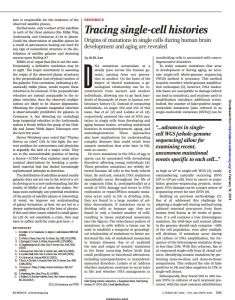Join getAbstract to access the summary!

Join getAbstract to access the summary!
Je H. Lee
Tracing Single-Cell Histories
Origins of mutations in single cells during human brain development and aging are revealed
Science, 2018
What's inside?
Advances in DNA sequencing technology help track the ramifications of DNA mutations in a single cell.
Recommendation
Je H. Lee, from the Cold Spring Harbor Laboratory, contextualizes the findings and ramifications of two new studies of DNA mutation rates. One used neuronal precursors and the other used mature neurons. Both concluded that the mutations yield mosaicism – populations of cells in the same brain with slightly different genomes – that might contribute to neurodegeneration. The two studies tackled the technical challenges of sequencing the DNA from a single cell very differently. getAbstract recommends this article to anyone curious about the current limitations and promise of DNA sequencing technology.
Summary
About the Author
Je H. Lee is an assistant professor at the Cold Spring Harbor Laboratory in New York. His lab studies how cells interact with their microenvironment to regulate gene expression during development.
















Comment on this summary